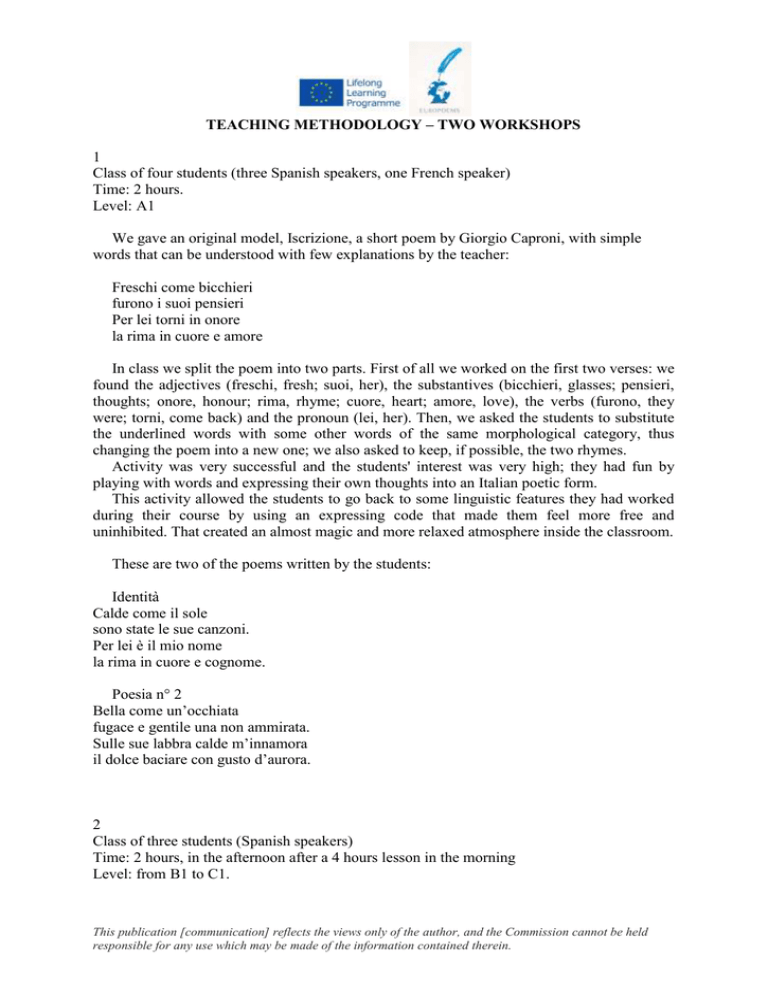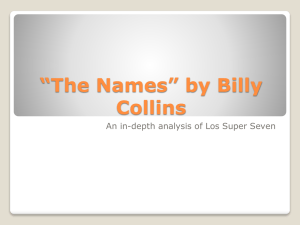File
advertisement

TEACHING METHODOLOGY – TWO WORKSHOPS 1 Class of four students (three Spanish speakers, one French speaker) Time: 2 hours. Level: A1 We gave an original model, Iscrizione, a short poem by Giorgio Caproni, with simple words that can be understood with few explanations by the teacher: Freschi come bicchieri furono i suoi pensieri Per lei torni in onore la rima in cuore e amore In class we split the poem into two parts. First of all we worked on the first two verses: we found the adjectives (freschi, fresh; suoi, her), the substantives (bicchieri, glasses; pensieri, thoughts; onore, honour; rima, rhyme; cuore, heart; amore, love), the verbs (furono, they were; torni, come back) and the pronoun (lei, her). Then, we asked the students to substitute the underlined words with some other words of the same morphological category, thus changing the poem into a new one; we also asked to keep, if possible, the two rhymes. Activity was very successful and the students' interest was very high; they had fun by playing with words and expressing their own thoughts into an Italian poetic form. This activity allowed the students to go back to some linguistic features they had worked during their course by using an expressing code that made them feel more free and uninhibited. That created an almost magic and more relaxed atmosphere inside the classroom. These are two of the poems written by the students: Identità Calde come il sole sono state le sue canzoni. Per lei è il mio nome la rima in cuore e cognome. Poesia n° 2 Bella come un’occhiata fugace e gentile una non ammirata. Sulle sue labbra calde m’innamora il dolce baciare con gusto d’aurora. 2 Class of three students (Spanish speakers) Time: 2 hours, in the afternoon after a 4 hours lesson in the morning Level: from B1 to C1. This publication [communication] reflects the views only of the author, and the Commission cannot be held responsible for any use which may be made of the information contained therein. We presented a model: Litania, by Giorgio Caproni. It is a long poem, but it has a very simple structure: it is formed by strophes made of two couplets, with rhymes AABB. It is about the city of Genoa (whose name is repeated at the beginning of each couplet); the city is described under every aspect with the use of adjectives and substantives. As it is made of more than 300 verses, we read just the beginning and the end of the poem. Before, we showed the students some pictures taken in Genoa, and then I let them notice how the description of the city is made not only through the view, but also through smells and the personal feelings of the poet (his family). Then we asked the students to think about a city they knew well and to write some notes in Italian that described it. They could write adjectives and substantives; verbs would be used in a second moment to connect the words between them. Then they were asked to put the words in groups connected by meaning: sounds, smells, people, colours, urban setting etc. Then we introduced the difficulty of the rhyme: we asked them to write and put the words they had written in a random order, and to complete the verses finding a rhyme; they could use an online rhyming dictionary. The students, in the end, wrote three poems that show a great fantasy, and they learned a lot of new words, that was the main learning aim of the activity. The teacher helped them in their writing, but only if he was asked to. Regarding the motivation of the learners, the girl who had the lower level (B1), and who, at the beginning of the course was very shy, during this activity relaxed and succeeded, and in the following lessons she was more active than before. Here is one of the three poems: Roma, mia città sognante sempre parlante. Roma città culturale cosmopolita, dominante. Roma ogni giorno vitale dolce, rumorosa, sentimentale. Roma tutta romantica vecchia e storica. Roma tutta rovine artistica, piena di vetrine. Roma, mangiona buona ascolta come suona. This publication [communication] reflects the views only of the author, and the Commission cannot be held responsible for any use which may be made of the information contained therein.








